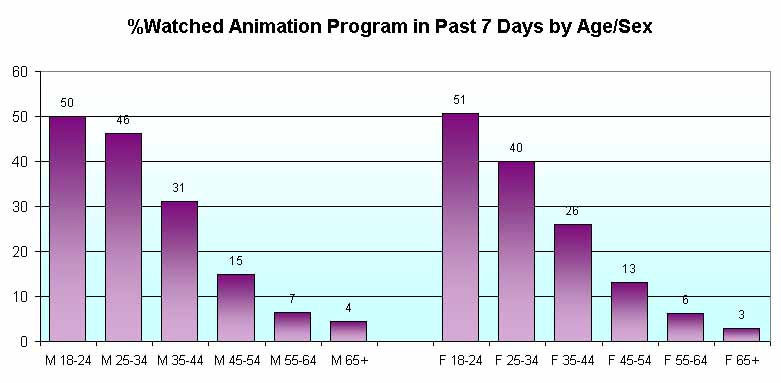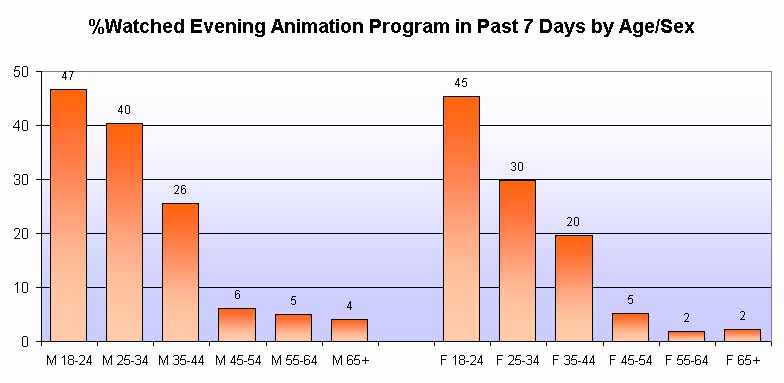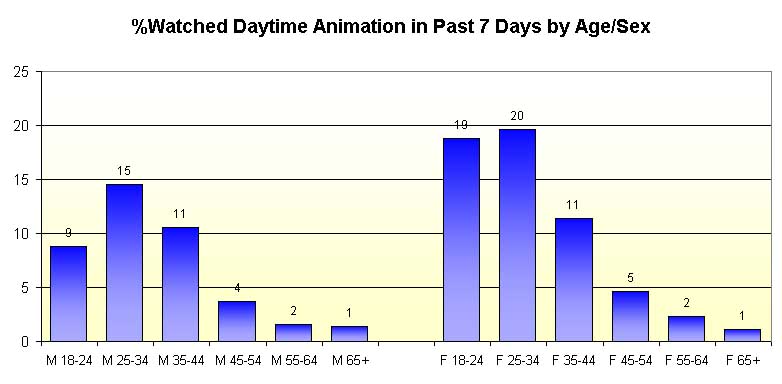
(source: 2004 MARS)
Cartoons for Adults
Yes, it is true that there are some cartoons and animations are made for adult viewing only, such as sexually explicit Japanese anime. No, that is the not the subject of this article. The subject here is cartoons that are made for children. As such, then, there should not be any significant number of adults in the viewing audience. Right? Wrong.
The MARS OTC/DTC Pharmaceutical Study is a mail survey conducted among adults (that is, persons age 18 or over) in the United States. This study is used for media planning in the pharmaceutical industry, so it is important to cover all the major television program categories. Certainly, the study covers programs such as news, sports, talk/conversation, daytime drama, movies, reality shows, game shows, audience participation programs, and so on. Within this list, there is the category known as 'daytime animation,' which are cartoons shown during the daytime and whose traditional audience is young children, either pre-school or elementary school.
The 2004 MARS study has 21,054 respondents who filled out survey questionnaires during the first quarter of year 2004. Within the study, 24% of the respondents said that they watched animation programs during the preceding seven days. In the following chart, we show the incidence of viewing animation by age/sex. The pattern of monotonic decline would fit a hypothesis that the viewing habit is something that was acquired at a young age and weaned off gradually over timed. And in the case of those who are older than 60 years old, they never even had television during their childhood.

(source: 2004 MARS)
But the story is actually more nuanced than that. As far as media planners and television programmers are concerned, there is a substantive difference between daytime and evening animation programs. Most adults work during the day and return home at night; thus, adults are not available during the day. Pre-school spend a lot of time with television during the morning and afternoon, and then they go to bed early. School children attend school during the days and return home in the early afternoon to watch television. Thus, there are in fact different types of animation programs that target these different segments.
In the next chart, we show the viewing to daytime versus evening animation programs by age/sex. In the case of evening animation programs, the monotonically declines are observed. This would be of interest to media planners who find it difficult to reach young adults through the traditional news and drama shows.

(source: 2004 MARS)
More interesting is the case of the daytime animation programs. Here the monotonic declines are no longer in evidence. Instead, the highest viewing groups are 25-34 year olds among men and 18-34 year olds among women. What gives?

(source: 2004 MARS)
Which adults stay home and watch cartoons during the day? An obvious answer is that there are parents who stay home to take care of their children, including watching television with them during the day as part of the bonding and educational process. Here are the bottomline figures:
How can a media planning leverage this information? Here are two examples:
Thus, daytime animation programs are efficient vehicles for reaching the purchasers of vitamins and allergy medicines for children. This little exercise serves to illustrate what was a seeming paradox about children as consumers. Question: Do you advertise to four-year-old children, who have zero purchasing power? Answer: No, when an advertisement appears on a program whose audience ought to be mostly small children, one may be targeting their parents who are watching the programs with the children.
(posted by Roland Soong, 11/18/2004)
(Return to Zona Latina's Home Page)